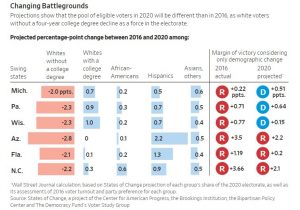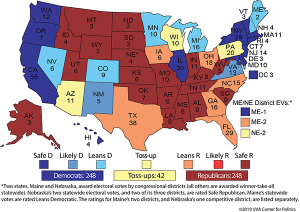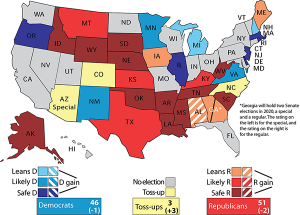As the New Year began, I mulled a perennial topic of Democratic strategy in a piece for New York:
As the voting phase of the 2020 Democratic presidential primary gets underway next month, fears about conflicts between candidates (and their supporters) weakening the party will begin to multiply. So aside from perpetual (and, in some respects, futile) efforts to assess each candidate’s “electability,” it makes sense to begin examining the most viable candidates in terms of their ability to unite Democratic voters for the mega-intense drive to November. Here are some strategies to consider.
Determine Which Groups Need to Come Together
The first step for any candidate hoping to unify the party is determining which factions are most essential for a 2020 win. Is it average voters? Certain demographic groups? Some combination of activists, opinion leaders, donors, and elected officials?
At this point, most Democratic primary voters don’t seem terribly inclined toward internecine conflict. An Economist-YouGov survey taken at the end of 2019 asks registered voters who say they plan to participate in Democratic primaries or caucuses: “Are there any presidential candidates that you would be disappointed if they became the Democratic nominee?” Multiple answers are allowed. Ex-Republican Mike Bloomberg attracted the most “disappointment,” at 34 percent, with Joe Biden coming in at 23 percent, Bernie Sanders at 20 percent, Andrew Yang at 18 percent, Pete Buttigieg and Amy Klobuchar at 17 percent, and Elizabeth Warren at 14 percent. Some findings don’t exactly match what you’d expect. Buttigieg is thought by some to have fatally alienated African-American voters. Yet in this survey, only 14 percent of black voters say they’d be disappointed if Mayor Pete is the nominee, less than the 17 percent who said the same of Sanders, whose African-American support levels (mostly among young black voters) are notably stronger this year than in 2016.
Among party elites, you’d get a different picture. Big donors are famously hostile to both Sanders and, perhaps even more particularly, to the Wall Street–focused Warren, despite her generally high ratings among rank-and-file Democrats. Elected officials are more prone to support Biden, and to fear Sanders, so far. The “Twitter Left” of typically young, typically ideological activists is hostile to Biden, as you might expect, but also arguably even more hostile to Buttigieg, whose combination of youth and centrism seems to annoy millennial progressives in a particularly intense way.In a piece presenting the argument for Sanders’s nomination, Matthew Yglesias suggests that lefty elites are potentially more troublesome in a general election than their less ideological counterparts, and thus need placating:
“Lots of moderate Democrats … find it annoying that Sanders and some of his followers are so committed to painting mainstream Democrats in such dark hues. And it is annoying! But annoying people won’t stop being annoying if he loses the nomination. If anything, they will be more annoying than ever as some refuse to get enthusiastic about the prospect of beating Trump. But if Sanders wins, partisan Democrats who just want to beat Trump will magically stop finding Bernie superfans annoying — the causes will be aligned, and the vast majority of people who want Trump out of the White House can collaborate in peace.”
If you are focused on the small factors that might make a difference in Democratic esprit de corps in a general election, eliminating the fights between Bernie-or-Bust folk and regular Democrats on social media that persisted in 2016 would make sense. But there is also the possibility that a Sanders (or Warren) nomination could give impetus to some sort of “centrist” third-party campaign like the one Howard Schultz threatened to wage earlier in the cycle, which for all its lack of natural voter appeal could serve as a lightning rod for Democratic-donor unhappiness. In other words, the target of each candidate’s unity effort will depend on identifying which voters are most put off by them.
Find Candidates With the Most “Unity” Potential
There are at least two traditional ways of assessing a candidate’s capacity to unify a potentially divided party that we can apply to the 2020 field: ideological positioning and second-choice support.
On the former point, being perceived as at the center of the party with respect to ideology can be a real asset. A new CBS-YouGov poll of Iowa asks if the various candidates are “too progressive,” “not progressive enough,” or “about right.” The rankings for “about right” are as follows: Buttigieg (65 percent); Biden (63 percent); Klobuchar (54 percent); Warren (44 percent); and Sanders (42 percent). Two candidates are far above average in the “too progressive” column: Sanders (50 percent) and Warren (41 percent). Two others stand out as “not progressive enough”: Klobuchar (35 percent) and Biden (31 percent).
But there are other respects in which candidates may or may not have the kind of broad appeal you’d want heading into a general election. Per the Morning Consult tracking poll, for example, Sanders is vastly more popular among younger voters and struggles toward the higher end of the age spectrum; to a less extreme extent, that is true of Yang as well. Biden and Buttigieg have the opposite problem. Warren displays fairly even levels of support by age. Biden, Sanders, Warren, and Yang have support spread reasonably well among white as well as nonwhite voters, while Buttigieg famously struggles with nonwhite voters.
Morning Consult regularly asks its large tracking-poll sample about second-choice candidates. In the latest poll, Sanders is the top second choice of Biden supporters (at 29 percent), followed by Warren (19 percent), Buttigieg (12 percent), and Bloomberg (11 percent). For Sanders supporters, the second choice is Warren (at 32 percent), followed by Biden (28 percent). Among Warren voters, the second preference is Sanders (33 percent) and Biden (24 percent). The runners-up for Buttigieg backers are Biden (27 percent) and Warren (20 percent).
More than anything else, these findings suggest that Biden and Sanders are both stronger unity figures than you might think. But candidates like Buttigieg, who are perceived as ideologically near the party’s center, have some strengths to build on as well.
Endorsements and Running Mates Can Help
As the nomination contest winds down, candidates will have other opportunities to broaden their appeal. First, they can seek endorsements from defeated candidates. Julián Castro’s endorsement of Warren shortly after he withdrew from the race may not bring her that much tangible help, given his own poor standing in the polls, but if others join him, that could burnish her reputation as a unity candidate. Conversely, in 2016, Sanders’s reluctance to endorse Hillary Clinton as soon as he might have (he waited until mid-July) contributed to a persistent sense of a divided party, even though Sanders energetically campaigned for the nominee later on.
Once a candidate has secured the nomination, they can reach out to disappointed party factions of identity groups via their choice of running mate. It is generally expected that any male nominee in 2020 will seek a woman as a running mate, and vice versa; the days of two white men forming a ticket are probably over for the time being among Democrats. But trans-ideological and multigenerational ticket-making could be a factor as well, if the nomination contest is close and tensions have developed.
The late-septuagenarians Biden and Sanders could have a particularly rich opportunity to promote unity in their veep selection, as either might be limited to a single term. Running with a younger, perhaps ideologically distinctive veep could essentially signal to Democrats jittery about them that their nomination wouldn’t necessarily represent some sort of definitive settlement on the party’s direction.
One unity tool that has never been tried by a Democrat (though Ronald Reagan briefly and unsuccessfully attempted it in 1976) is the choice of a coalition-building running mate before the nomination is secured. Hints were dropped by Biden’s campaign that he might try that gambit in 2020, with former Georgia gubernatorial nominee Stacey Abrams being the putative veep whose name was most mentioned. Abrams ruled it out for the time being, but not for good, and Biden (or some other candidate) could come back around to the idea between now and the convention.
Surviving Contested Conventions and Other Late Threats to Solidarity
The need for party unity could skyrocket if certain events threaten to further divide Democrats. A contested convention is unlikely but possible, and would certainly make unity gestures very important in restoring normalcy before the sprint to November began. Or if the primaries produce a nominee (Sanders? Biden? Buttigieg?) who provokes threats of defections to a third-party candidate or to the living-room couch on Election Day, then deploying opinion leaders with credibility among disaffected voters would be important. In general, the closer the ultimate contest looks, the more essential it will be to convey the impression that all hands must be on deck.
There Could Be Several “Unity Candidates”
A unified Democratic Party is within the grasp of any nominee, mostly thanks to the Great Unifier in the Oval Office, whose sins make those of any competitor pale by comparison, and whose second term could represent a veritable hellscape for the party and the country. But the need for unity should cross the minds of eager Democrats every time they speak to a reporter or post on Twitter about the unacceptable characteristics of candidates other than their own. It’s not just that the infernal forces of MAGA will repeat, amplify, and exaggerate any such negative talk no matter how hypocritical it may be to do so; it’s also that it may not take much to convince low-information voters that “they’re all just lying politicians” — so why not stay home, or vote for the devil that you know?








